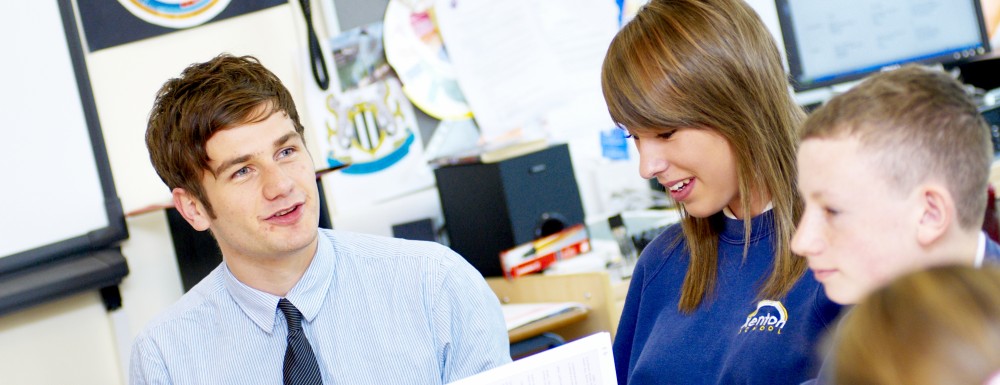
Sugata Mitra with children at a hole-in-the-wall project in Delhi in 2011 Photograph: TED
At the School in the Cloud, volunteer ‘grannies’ use Skype to help some of the world’s poorest children teach themselves. Could mainstream education learn from them?
Every week Lorraine Schneiter, a former Open University tutor, sits down in front of her computer, opens up Skype, and calls a group of children in India. And then they chat.
What about? “It depends on them. I have some suggestions up my sleeve but I always try to wait and see what they want to talk about. And then I’m always trying to make sure it’s relevant to their lives. I don’t like the idea of us zooming in from the west and trying to wave some wand over Indian children.”
Lorraine is 53 and has been running the Skype sessions for the last three years as a member of the “granny cloud” – a hundred of so people who have volunteered to talk to, read with, question and encourage schoolchildren via Skype.
Not all the grannies are grannies – Lorraine has only recently become an actual grandmother – and they’re not necessarily women or any particular age, but Suneeta Kulkarni, the research director of the project, tells me that they’ve never been able to shake the name. “We called it something like ‘self-organised mediation environment’but we’ve given up. It never stuck. It is the granny cloud now.”
It’s just one part of a bold education experiment – the “School in the Cloud” – that began in Newcastle and has now gone global. It’s the brainchild of Sugata Mitra, 64-year-old professor of educational technology at the University of Newcastle, who stumbled across what he considered a startling discovery 15 years ago when he was chief scientist at a computer company in Delhi. A theoretical physicist by training, his job was to look at new technologies and one day his boss asked him to investigate public computers. On nothing much more than a whim, he undertook an ad hoc experiment. “I just called my two assistants into his office and said, ‘Let’s make a hole in that wall and stick the computer out there at a height children will be able to use.’ We just pulled out wires from the office network and connected it and pushed it out of the wall. ”
His office bordered a slum. “I had a piece of software which would show me what’s on the screen on that computer. And things just started appearing on it.”
Like what? “Well, first we saw the mouse beginning to move. We said, ‘Oh, so they’ve figured the mouse out.’ Even that was a surprise because these children had never seen a computer before and were mostly illiterate. And then after about an hour they were double-clicking on things. And then a night passed and we came back and found a Word file with someone’s name written on it. And we were like, ‘We haven’t given them a keyboard. How are they typing?’ So we had to go out and see what they were doing. They’d found something called a character map, which is in Word. Most people didn’t even know it’s there. But they’d found it and were using it to type.”
The Times of India wrote a story about the slum kids who’d taught themselves to use computers and Mitra went on to conduct further “hole-in-the-wall” experiments in different areas of India.
A decade later, when the film Slumdog Millionaire was released, he read an interview with author Vikas Swarup, on whose novel the film was based, and discovered that his project had been the inspiration for the self-educated protagonist. Overnight, he became the “slumdog professor” – “though we’ve always said that we weren’t interested in creating slumdog millionaires, we want slumdog Nobel laureates”.
Mitra wanted to test how far he could push the concept, how much children could learn by themselves. “I set myself an impossible target: can Tamil-speaking 12-year-old children in a south Indian village teach themselves biotechnology in English on their own?” When he returned two months later, they told him they’d learned “nothing”. “And then a 12-year-old girl raises her hand and says, ‘Apart from the fact that improper replication of the DNA molecule causes genetic disease, we’ve understood nothing else.’ ”
The group scored an average of 30% in a test he gave them, and after he employed a local young woman to stand behind them and act as a “grandmother”, saying encouraging things, the results went up to 50% – as good as those achieved by a high-performing school in Delhi with a specialist biotech teacher.
As Mitra thought about what was happening, his background in physics informed his ideas. “With the hole-in-the-wall, I’d just watch this trial-and-error process going on with practically illiterate children. So that’s when I began to get a feeling that this is not related to literacy. Then as I went on doing more experiments, it turned out that it wasn’t really related to anything. It seemed to be like random chaotic behaviour that resulted in ordered things in the end. In physics, we call this a self-organising system, like an ant hill.”
In 2010, he gave a TED talk on the subject and in 2013 he won the $1m (£640,000) TED prize to build a “School in the Cloud” and this is where Lorraine Schneiter and her co-grannies come in. Mitra has set up seven so-called Soles in India and the UK – self-organised learning environments – to test the theory that children, in small groups, with access to a computer and a few other conditions, can essentially learn by themselves.
The kind of education that schools offer is completely out of date, in Mitra’s view. “It’s fashionable to say the education system is broken. It’s not broken at all. The Victorian system, which is the model of education used practically everywhere in the world, does exactly what it was designed to do. Which is to have an elite class who will run the show, assisted by an army of clerks for whom a curriculum was designed and who were mass-produced to do their jobs.
“So, it’s not broken, but what it is producing are people who are not needed. You know, an average boy from an average school in a poorer area would go out for a job interview, and the employer says, ‘What can you do well?’ And he’ll say, ‘I have good handwriting, my grammar’s excellent, I can spell properly and I can do arithmetic in my mind.’
“Well, if I was the boss I would think: I don’t care about your handwriting, everything’s done on computers. Grammar is not particularly important, we deal with the Chinese and the Americans who don’t bother about grammar at all, as long as it makes sense. Spelling is corrected by the computer and you don’t need to know anything about arithmetic. In fact the less arithmetic you do in your head the better.”
But then again, I say, if the applicant has got five GCSEs, at least the employer knows they’re able to apply themselves, and that they have a certain intelligence.
“But that’s the only thing that you can derive from five GCSEs. You’re able to work hard, to fit into the system properly. But increasingly inside the modern world, particularly the IT industry, these are not considered as very good traits at all. What you want are people who don’t care about how they dress, don’t care about how they talk, would like to think of things from different angles. These are the guys who do well. So, you’re producing the wrong product. It’s a factory left over from an era that has gone away.”
The world’s education system was designed to man the empire, he argues. The Sole method, or child-directed self-learning, is about acquiring the skills that people need in today’s world: how to research information, evaluate sources, work in teams.
“There already is some sort of collective global consciousness out there,” he says. “One way to put it, which may not be very popular but still, is that perhaps knowing is obsolete. People often think I’m saying that knowledge is obsolete, which I’m not. I’m saying putting knowledge in your head – that’s obsolete, because you can know anything when you need to know it via the internet.”
It’s the kind of statement that’s not without its critics. Larry Cuban, professor emeritus of education at Stanford University, who has critiqued a tendency to see technology as a kind of “magical thinking” that will cure all ills, tells me that he thinks Sugata Mitra’s Sole project “fits the current enthusiasm for technology applied to children”. He points out that “part of it is dollar-driven. It’s far cheaper for policymakers to organise children around devices and have them learn knowledge and skills informally than to build schools, train and hire teachers, establish a curriculum, hold teachers responsible for what is learned etc.”
It’s a renaissance of the “progressive vision of child-driven learning” that gave birth to alternative schools such as Summerhill, he says. And though he says he can understand the appeal in India and other developing nations, he cautions: “There has been no reliable, independent evaluation of Sole and similar projects yet.”
Even so, enthusiasm for the project continues to grow. Suneeta Kulkarni tells me that she gets inundated with queries. “We have people from all over the world getting in touch with us, it’s become a genuinely worldwide movement. I had someone from Rajasthan this morning and there are now Soles in Colombia, Mexico, Cambodia, Greenland. It’s incredibly diverse.” Their figures show that the Sole toolkit from the School in the Cloud website has been downloaded more than 67,000 times, and more than 10,000 Soles have been set up across five continents, though they don’t have data on how many of these are active.
The “granny cloud” is an essential part of the Sole method. Kulkarni tells me the first volunteers came via a story in the Guardian. There are around 120 “grannies” presently, “and we are always looking for more, we need at least 300 now. The idea is that these volunteers act like grandmothers, which is to say they are warm and friendly and encouraging.
“So much of the internet is in English so if children don’t speak English they don’t have access to this information. We try and simulate the kind of environment where children pick up a language very naturally by telling stories and singing songs, and it’s been critical to the success of what we are trying to do.”
Kulkarni, a retired child psychologist based in Pune, India, is the epitome of this: she is naturally warm and friendly and encouraging even to random journalists who ring her from Britain. And Lorraine Schneiter too, who tells me she learns as much from the children as they do from her. “They’re absolutely wonderful,” she says. “I get as much out of it as they do, if not more.” In three years, she’s seen how their language skills improve and the way they grow in confidence.
Criticism of the project, says Kulkarni, “is from places where what’s available is already good, there are a lot of resources, children are already getting a good education. Whereas in the kind of places we set up Soles there’s nothing. It can make the world of difference. We see it in the command of English, in their confidence, in their aspirations.” And she tells me about Arun Chavan, who as a child participated in one of the original hole-in-the-wall projects and is now at Yale doing a PhD in evolutionary biology.
Later, I get hold of Chavan to ask him about the impact of the hole-in-the-wall project on his educational achievement, and there’s a pause while he thinks about how to answer. “I’ve been asked this before and I’m always really uncomfortable with the idea of this as a hole-in-the-wall to Yale kind of story,” he says. “I feel like some of the most important influences I had were the people I had the opportunity to meet. It opened up my mind to a lot of things.”
It’s not a magic bullet, then? “No, technology is not a magic bullet. I wouldn’t be the only person saying it. But then, when it comes to something as complex as education, nothing is magic.”
Sugata Mitra’s unique approach to education is probably in part due to the fact that he’s not an educationalist. Or at least he wasn’t in a career sense until he moved to Newcastle. He wasn’t even a full-time academic; he wrote papers in his spare time from his job at NIIT, a multinational computer firm. He grew up in a privileged family in Kolkata, studied physics, specialising in battery storage, and came to computers by accident. “The first task I was given by my supervisor as a PhD student was to fix the computer program. And, I still remember I asked him, ‘What’s a computer program?’ And, he said, ‘Read some book and just fix the program, OK?’ And went away. So, I bought myself a book and taught myself how to write programs and I really loved it.”
He’s a believer in the same kind of first principles that he now advocates for children. As a student, he used to do all sorts of experiments on the side. “I remember one was testing out if there’s any truth in astrology.”
But then his unorthodox approach to academia is also evident in other parts of his life. He tells me, as an aside, how he bought “the cheapest house in Newcastle”. How much was the cheapest house in Newcastle? “Forty-five thousand pounds,” he says. It’s in Gateshead, in an area popular with Travellers. He bought it, he says, when he was invited to be a visiting professor at MIT and decided he didn’t want to waste money paying rent if he wasn’t going to be there that often. “And it’s a dream. A house with an upstairs and downstairs and a front and back garden. I find it very convenient and very comfortable. And I really fell in love with that area because it’s so green and wide open.”
Is there a Mrs Mitra?
“Yes, and she lives there.”
She didn’t kick up and say, take me back to Kolkata?
“She did. But we go back every year and there we have a nice big house. And she fell in love with it [the Gateshead house] too. She says it’s like a doll’s house. And I said to the town’s head that when I lived in Jesmond [a middle-class suburb], I noticed that the streets were cleaned and where I’m living now, they’re not. And I said, ‘Don’t you want to do it for poor people? Because I’m not poor at all and I’d like the road to be cleaned.’ So now they clean it very well.”
It’s something of the same spirit that informs his educational experiments. Part of what inspired the hole-in-the-wall project was seeing how quickly his son picked up computer skills at home and thinking how unfair it was that not all children had this chance. And there’s no doubt that a lot of the success of the project is down to Mitra himself. He’s the kind of genuinely charismatic and inspiring teacher that he seems to be trying to demonstrate isn’t needed any more.
Sally Rix, an ex-teacher who’s now researching a PhD on Sole after meeting Mitra when he visited her school, is just one of those he’s inspired: “He’s incredibly passionate about improving learning. I think he just finds it incredibly frustrating that this system that developed in the 19th century is still the prevailing model today. And he’s genuinely curious about everything. I couldn’t name very many people like that. He has this voracious appetite for learning and doing things.”
“He’s quite a charmer,” Lorraine Schneiter tells me, “and it made me quite sceptical at first. I know a lot of teachers have been quite hostile to him, certainly in Britain. But I think it’s because they’re so used to being threatened. They could just imagine someone like Gove saying, ‘OK let’s get rid of half the teachers.’ But it is quite bold and radical and we are all just trying to find our way. It’s fascinating because we really are seeing how some things work and some things don’t. It’s a very experimental approach.
“But I do think he’s right. The world has changed. My father was an airline pilot and he had to be completely retrained to fly a 747, which used computers. It required a completely different approach. The key was to not remember things by heart. They didn’t want you remembering things by heart. The key was to find the information you needed.”
The popularity of Mitra’s approach has provoked a backlash. “He can sometimes be quite deliberately controversial,” says Rix. Particularly with regards to teachers. At one point I say to him that self-learning is all well and good but that a good teacher doesn’t just dole out information. They have all sorts of human qualities that are as important as the quality of the information they’re imparting.
“Yes,” says Mitra. “And there was a time when they used to reduce blood pressure by bloodletting and a very well-trained physician used to come and he was human and warm and he used to explain that he’s going to cut one of your veins and drain the blood out into a bucket until the blood pressure drops. The question is whether we will miss him or not once we have pills.”
It’s arguable whether this is a helpful line of argument, especially given that teachers tend to be the most enthusiastic proponents of the School in the Cloud. The enthusiasm of Amy-Leigh Hope, a design technology teacher at George Stephenson high school in Newcastle, for Mitra’s ideas led to the school getting involved and becoming one of his UK Sole centres. “The reason I went into teaching was because I wanted to inspire children to learn, so I do find it very satisfying,” she says. “The children are in charge of their learning and it’s very engaging. They have to look for the answers. They own the information in a way they don’t when you just tell them the answers.”
Two years ago, I went to see the process in action at her school and I can see what she means. I sat in on an art lesson that Mitra conducted and it was fascinating how the children approached the task so differently. “There’s a painter,” Mitra told them, “and I can barely spell his name. Cézanne. He painted still lifes. Do you know what a still life is? No, well we have to figure this out.”
The rules were that there were no rules, or at least not many of them. “Nobody is going to supervise you. You can walk around as much as you like, you can change groups, but at the end of it, each group will tell us about Cézanne, still lifes, and light and shade.”
With the Sole method, children are set a question and then work in groups to figure it out. I watched as one group of boys typed variations of “Susan” and “Suzanne” into Google for a good 10 minutes. In another group, one of the boys said: “Just go to Wikipedia!” And another told him: “Wikipedia is not true! Do you know that if you sign up, you can edit Wikipedia?” But then, they found the word “chiaroscuro” and started studying images of Cézanne’s paintings. And I watched as they really did look at them. “Look, he uses the light to make this 3D effect,” one of them said. They were examining the evidence and figuring it out for themselves.
Meanwhile, I couldn’t help finding it a bit depressing that the group of girls had written an elaborate “Cézanne” at the top of the sheet of paper that was supposed to display their results and three of them were colouring it in, while just one of them attempted to find out some information at the computer. “It’s conditioning,” Mitra said later when I asked him about it and he pointed out one of the flaws of his own system. “It’s worse in places where girls have been told to be quiet, so they don’t talk. That obviously pulls their results down.”
At the end, the children presented their findings. They were highly variable. The group that had Googled “Suzanne” had struggled to find out very much at all and I couldn’t help thinking that what I was seeing was bright kids thriving and the less bright ones struggling. But given that we all use the internet all the time to find things out, being able to find the right information, and evaluate it, is an undeniable life skill to learn.
Personally, I suspect Arun Chavan is right: there’s probably no magic bullet. I’m not sure the girls in that class were much wiser about Cézanne, but two years on, I’d put a bet on those boys. I thought I understood what chiaroscuro meant but watching them figure it out by themselves made me realise that I did so at only the most superficial level. It turns out that, in some circumstances at least, the kids are pretty good at doing it for themselves.
For more information on becoming a “granny”, click here
This was taken from the Education section of the Guardian
Written by Carole Cadwalladr, feature writer of the Observer.









